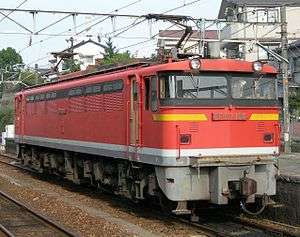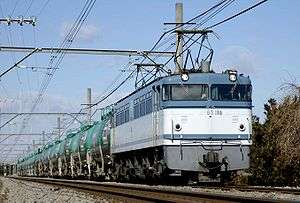JNR Class EF65
|
Refurbished JR Freight EF65 118, February 2008 | |||||||||||||||||||||||||||
| |||||||||||||||||||||||||||
| |||||||||||||||||||||||||||
| |||||||||||||||||||||||||||
| |||||||||||||||||||||||||||
The Class EF65 (EF65形) is a 6-axle (Bo-Bo-Bo wheel arrangement) DC electric locomotive type operated on passenger and freight services in Japan since 1965.
As of 1 April 2009, JR Freight operated 77 locomotives, JR East operated 8 (EF65-1000), and JR West operated 10 (EF65-1000) locomotives.[2]
Variants
The class was initially divided into the EF65-0 subclass for general freight and the EF65-500 subclass for express freight and passenger use.[3]
- EF65-0: Numbers EF65 1 – 135
- EF65-500: Numbers EF65 501 – 542
- EF65-1000: Numbers EF65 1001 – 1139
- EF65-2000:
Background and history
The Class EF65 was designed by Japanese National Railways (JNR) as a standard locomotive type developed from the earlier Class EF60 design for use primarily on the Tokaido Main Line and Sanyo Main Line.[3]
Operations
During the JNR era, these locomotives were used for freight trains and also for passenger work - primarily hauling night trains such as the Izumo sleeping car limited express and Ginga sleeping car express.
EF65-0
The EF65-0 subclass was designed for general freight use on the Tokaido Main Line and Sanyo Main Line. 135 locomotives were built between 1965 and 1970.[4]
 JR Freight EF65 100 in original blue livery, March 2008
JR Freight EF65 100 in original blue livery, March 2008 Refurbished JR Freight EF65 114, February 2010
Refurbished JR Freight EF65 114, February 2010
EF67 banker conversions

Five 6th-batch Class EF65-0 locomotives, numbers EF65 131 to EF65 135, were converted in 1990 and 1991 to become Class EF67-100 banking locomotives for use on the "Senohachi" section of the Sanyo Main Line.[5]
| Original number | Built | Later number | Rebuilt |
|---|---|---|---|
| EF65 131 | 16 July 1970 | EF67 102 | 1 May 1990 |
| EF65 132 | 20 July 1970 | EF67 104 | 9 November 1990 |
| EF65 133 | 30 July 1970 | EF67 103 | 29 September 1990 |
| EF65 134 | 6 August 1970 | EF67 101 | 23 March 1990 |
| EF65 135 | 20 August 1970 | EF67 105 | 8 March 1991 |
EF65-500
The EF65-500 subclass consisted of a total of 42 locomotives, including newly built locomotives and locomotives (EF65 535 - 542) modified from the earlier EF65-0 subclass (EF65 77 - 84) for use on overnight sleeping car services and express freight services operating at a maximum speed of 110 km/h (70 mph).[4]
P/F designation
Locomotives used for hauling passenger services are referred to as "P" type, and those used for freight services are referred to as "F" type.[3] The original designations are as shown below.[3]
| Locomotive number | P/F designation |
|---|---|
| EF65 501 | P |
| EF65 502 | P |
| EF65 503 | P |
| EF65 504 | P |
| EF65 505 | P |
| EF65 506 | P |
| EF65 507 | P |
| EF65 508 | P |
| EF65 509 | P |
| EF65 510 | P |
| EF65 511 | P |
| EF65 512 | P |
| EF65 513 | F |
| EF65 514 | F |
| EF65 515 | F |
| EF65 516 | F |
| EF65 517 | F |
| EF65 518 | F |
| EF65 519 | F |
| EF65 520 | F |
| EF65 521 | F |
| EF65 522 | F |
| EF65 523 | F |
| EF65 524 | F |
| EF65 525 | F |
| EF65 526 | F |
| EF65 527 | P |
| EF65 528 | P |
| EF65 529 | P |
| EF65 530 | P |
| EF65 531 | P |
| EF65 532 | F |
| EF65 533 | F |
| EF65 535 | F |
| EF65 536 | P |
| EF65 537 | P |
| EF65 538 | P |
| EF65 539 | P |
| EF65 540 | P |
| EF65 541 | P |
| EF65 542 | P |
- EF65 501 in original tokkyū livery, August 2008
 Refurbished JR Freight EF65 528, July 2007
Refurbished JR Freight EF65 528, July 2007
EF65-1000
The EF65-1000 was intended for use on both passenger and freight services, and was referred to as the "PF" type. 139 locomotives were built between 1969 and 1979.[4]
 Passenger EF65 1135 in original "tokkyū" livery, March 2008
Passenger EF65 1135 in original "tokkyū" livery, March 2008 Refurbished JR Freight EF65 1042, May 2006
Refurbished JR Freight EF65 1042, May 2006
EF65-2000
There are former Class EF65-1000 locomotives renumbered from May 2012 by JR Freight to differentiate them from locomotives fitted with driving recording units mandated for operations over 100 mph (160 km/h).[3]
 EF65 2121 in original tokkyu livery, August 2012
EF65 2121 in original tokkyu livery, August 2012 EF65 2101 in refurbished JR Freight livery, October 2012
EF65 2101 in refurbished JR Freight livery, October 2012
Livery variations
- EF65 9: Repainted in early-style all-over brown livery with white ("JR貨物", JR Freight) lettering on the side[6]
- EF65 57: Repainted in early-style all-over brown livery
- EF65 105: Repainted in Euroliner livery[6]
- EF65 116: Repainted in blue with large yellow "JR" lettering on the sides and yellow bands on the cab ends[6]
- EF65 123: Repainted in Yuyu Salon Okayama livery (initially maroon, later orange)[6]
- EF65 1019: Repainted in Super Express Rainbow red livery in March 1987. Removed from service on 31 December 1997, and withdrawn on 1 September 1998.[7]
- EF65 1059: Repainted in blue with yellow front-end warning panels and large "JR" logo in July 1987. Remained in this livery until withdrawal on 31 March 2009.[8]
- EF65 1065: Experimental JR Freight livery[6]
- EF65 1118: Super Express Rainbow livery
- EF65 1124: Twilight Express dark green and yellow livery from November 2015[9]
 Brown-liveried JR Freight EF65 9 in 1989
Brown-liveried JR Freight EF65 9 in 1989 JR Freight EF65 57 specially repainted in early-style brown livery in March 2005
JR Freight EF65 57 specially repainted in early-style brown livery in March 2005 EF65 105 in Euroliner livery
EF65 105 in Euroliner livery EF65 123 in original maroon Yuyu Salon Okayama livery
EF65 123 in original maroon Yuyu Salon Okayama livery EF65 123 in later orange Yuyu Salon Okayama livery
EF65 123 in later orange Yuyu Salon Okayama livery EF65 1019 in Super Express Rainbow livery
EF65 1019 in Super Express Rainbow livery EF65 1059 in experimental JR Freight livery
EF65 1059 in experimental JR Freight livery EF65 1065 in experimental JR Freight livery
EF65 1065 in experimental JR Freight livery JR East Super Express Rainbow liveried EF65 1118 in October 2010
JR East Super Express Rainbow liveried EF65 1118 in October 2010 JR West EF65 1124 in Twilight Express livery in December 2015
JR West EF65 1124 in Twilight Express livery in December 2015
Preserved examples
- EF65 1: Preserved at the Kyoto Railway Museum in Kyoto.[10]
- EF65 5: JR Freight Ōi Depot in Shinagawa, Tokyo (training use)[11]
- EF65 520: Usui Pass Railway Heritage Park, Gunma Prefecture[11]
- EF65 535: Originally stored at Ōmiya Works, Saitama Prefecture, and donated to Toshiba in Fuchu, Tokyo in March 2013[12]
- EF65 536: Sekisui Kinzoku factory, Saitama Prefecture (cab only)[11]
- EF65 539: Privately preserved in Gunma Prefecture (cab only)[11]
- EF65 1001: JR Freight Ōi Depot in Shinagawa, Tokyo (training use)[11]
 EF65 520 at the Usui Pass Railway Heritage Park in April 2011
EF65 520 at the Usui Pass Railway Heritage Park in April 2011- EF65 535 at Omiya Works in May 2008
See also
References
- ↑ Inoue, Kōichi (1999). 国鉄機関車辞典 [JNR Locomotive Encyclopedia]. Japan: Sankaido. pp. 118–121. ISBN 4-381-10338-6.
- ↑ ""JR各社の車両配置表" (JR Group company fleet allocations)". Japan Railfan Magazine. Vol. 49 no. 579. Japan: Kōyūsha. July 2009. pp. 1–48.
- 1 2 3 4 5 JR機関車カタログ [JR Locomotive Catalogue]. Japan: Ikaros Publications Ltd. 20 June 2013. pp. 28–31. ISBN 9784863207271.
- 1 2 3 JR全車輌ハンドブック2009 [JR Rolling Stock Handbook 2009]. Japan: Neko Publishing. 2009. pp. 33–35. ISBN 978-4-7770-0836-0.
- ↑ Seki, Takahiro (December 2012). "セノハチの後押し機関車" [Senohachi Banking locomotives]. Japan Railfan Magazine. Vol. 52 no. 620. Japan: Koyusha Co., Ltd. pp. 86–93.
- 1 2 3 4 5 JR全車輛ハンドブック'92 [JR Rolling Stock Handbook 1992]. Japan: Neko Publishing. 1992. pp. 33–35.
- ↑ "EF65 1019". Tetsudo Hobidas (in Japanese). Japan: Neko Publishing Ltd. January 2013. Retrieved 8 January 2013.
- ↑ "EF65 1059". Tetsudo Hobidas (in Japanese). Japan: Neko Publishing Ltd. November 2012. Retrieved 6 November 2012.
- ↑ EF65 1124がトワイライト色に [EF65 1124 repainted into Twilight livery]. Japan Railfan Magazine Online (in Japanese). Japan: Koyusha Co., Ltd. 13 November 2015. Retrieved 15 November 2015.
- ↑ 京都鉄道博物館 [Kyoto Railway Museum]. Japan Railfan Magazine (in Japanese). Vol. 56 no. 662. Japan: Koyusha Co., Ltd. June 2016. p. 47.
- 1 2 3 4 5 Sasada, Masahiro (25 November 2014). 国鉄&JR保存車大全2015-2016 [JNR & JR Preserved Rolling Stock Complete Guide 2015-2016] (in Japanese). Tokyo, Japan: Ikaros Publications Ltd. p. 122. ISBN 978-4863209282.
- ↑ "EF65 535が東芝府中事業所へ" [EF65 535 moved to Toshiba Fuchu factory]. RM News (in Japanese). Japan: Neko Publishing Ltd. 12 March 2013. Retrieved 11 March 2013.
| Wikimedia Commons has media related to JNR EF65. |

